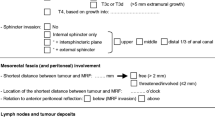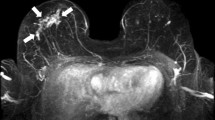Abstract
Objective
The purpose of this study is to evaluate the role of multi-voxel proton MR spectroscopy in differentiating benign and malignant musculoskeletal tumours in a more objective way and to correlate the MRS data parameters with histopathology.
Methods and materials
A hospital-based prospective study was carried out comprising 42 patients who underwent MRI examinations from 1 July 2013 to 30 June 2014. After routine sequences, single-slice multi-voxel proton MR spectroscopy was included at TE-135 using the PRESS sequence. The voxel with the maximum choline/Cr ratio was used for analysis of data in 32 patients. The strength of association between the MR spectroscopy findings and the nature of tumour and histopathological grading were assessed.
Results
Of the 42 patients, the MR spectra were not of diagnostic quality in 10. In the remaining 32 patients, 12 (37.5%) had benign and 20 (62.5%) malignant tumours. The mean choline/Cr ratio was 6.97 ± 5.95 (SD) for benign tumours and 25.39 ± 17.72 (SD) for malignant tumours. In our study statistical significance was noted between the choline/Cr ratio and the histological nature of musculoskeletal tumours (p = 0.002) assessed by unpaired t-test. The choline/Cr ratio and histological grading were also found to be significant (p = 0.001) when assessed by one-way ANOVA test.
Conclusions
Multi-voxel MR spectroscopy showed a higher choline/Cr ratio in malignant musculoskeletal tumours than in benign ones (p = 0.002). The choline/Cr ratio and histological grading of musculoskeletal tumours also showed statistical significance (p = 0.001).









Similar content being viewed by others
References
Stark DD, Bradley WG. Magnetic Resonance Imaging, 2nd ed. St. Louis Mosby-Year Book 1992.
Wang CK, Hsieh TJ, Jaw TS, Lin JN, Liu GC, Li CW. Clinical application of in vivo proton (1H) MR spectroscopy. Spectroscopy. 2005;19:181–90.
Rosenberg AE. Chapter 26- Bones, Joints, and Soft Tissue Tumours, Kumar V, Abbas AK, and Fausto N, Robbin and Cotran Pathologic Basis of Disease, 7th edition, Elsevier Inc. India; 2004:1273-1324.
Daniel Jr A, Ullah E, Wahab S, Kumar Jr V. Relevance of MRI in prediction of malignancy of musculoskeletal system—A prospective evaluation. BMC Musculoskelet Disord. 2009;10:125.
Hermann G, Abdel Wahab IF, Miller TT, Klein MJ, Lewis MM. Tumour and tumour-like conditions of the soft tissue: magnetic resonance imaging features differentiating benign from malignant masses. Br J Radiol. 1992;65(769):14–20.
Alyas F, James SL, Davies AM, Saifuddin A. The role of MR imaging in the diagnostic characterisation of appendicular bone tumours and tumour-like conditions. Eur Radiol. 2007;17(10):2675–86.
Sah PL, Sharma R, Kandpal H, Seith A, Rastogi S, Bandhu S, et al. In vivo proton spectroscopy of giant cell tumor of the bone. Am J Roentgenol. 2008;190:433.
Van der Graaf M. In vivo magnetic resonance spectroscopy: basic methodology and clinical applications. Eur Biophys J. 2010;39:527–40.
Wang CK, Li CW, Hsieh TJ, Chien SH, Liu GC, Tsai KB. Characterization of bone and soft-tissue tumors with in vivo 1H MR spectroscopy: initial results. Radiology. 2004;232:599–605.
Subhawong TK, Wang X, Durand DJ, Jacobs MA, Carrino JA, Machado AJ, et al. Proton MR spectroscopy in metabolic assessment of musculoskeletal lesions. Am J Roentgenol. 2012;198:162–72.
Fayad LM, Wang X, Salibi N, Barker PB, Jacobs MA, Machado AJ, et al. A feasibility study of quantitative molecular characterization of musculoskeletal lesions by proton MR spectroscopy at 3 T. Am J Roentgenol. 2010;195:207.
Marks KE, Belhobek GH. Chapter 10. Tumours of the Musculoskeletal System. Robert B Duthie & George Bently. Mercer’s Orthopaedic Surgery, 9th ed. Jaypee Brothers. India, 2003;653-676.
Toro JR, Travis LB, Wu HJ, Zhu K, Fletcher CD, Devessa SS. Incidence patterns of soft tissue sarcomas, regardless of primary site, in the surveillance, epidemiology and end results program, 1978-2001: An analysis of 26,758 cases. Int J Cancer. 2006;119(12):2922–30.
Murphey MD, Nomikos GC, Flemming DJ, Gan-non FH, Temple HT, Kransdorf MJ. From the Archives of the AFIP: Imaging of giant cell tumor and giant cell reparative granuloma of bone: radiologic-pathologic correlation. RadioGraphics. 2001;21(5):1283–309.
Law M, Yang S, Wang H, Babb JS, Johnson G, Cha S, et al. Glioma grading: sensitivity, specificity, and predictive values of perfusion MR imaging and proton MR spectroscopic imaging compared with conventional MR imaging. Am J Neuroradiol. 2003;24:1989–98.
Bartella L, Morris EA, Dershaw DD, Liberman L, Thakur SB, Moskowitz C, et al. Proton MR spectroscopy with choline peak as malignancy marker improves positive predictive value for breast cancer diagnosis: preliminary study. Radiology. 2006;239:686–92.
Akin O, Hricak H. Imaging of prostate cancer. Radiol Clin N Am. 2007;45:207–22.
Mountford C, Lean C, Malycha P, Russell P. Proton spectroscopy provides accurate pathology on biopsy and in vivo. J Magn Reson Imaging. 2006;24:459–77.
Ackerstaff E, Glunde K, Bhujwalla ZM. Choline phospholipid metabolism: a target in cancer cells? J Cell Biochem. 2003;90:525–33.
Ruiz-Cabello J, Cohen JS. Phospholipid metabolites as indicators of cancer cell function. NMR Biomed. 1992;5:226–33.
Zakian KL, Sircar K, Hricak H, Chen HN, Shukla-Dave A, Eberhardt S, et al. Correlation of proton MR spectroscopic imaging with Gleason score based on step-section pathologic analysis after radical prostatectomy. Radiology. 2005;234:804–14.
Mullins ME. MR spectroscopy: truly molecular imaging—past, present and future. Neuroimaging Clin N Am. 2006;16:605–18.
Meisamy S, Bolan PJ, Baker EH, Bliss RL, Gulbahce E, Everson LI, et al. Neoadjuvant chemotherapy of locally advanced breast cancer: predicting response with in-vivo 1H MR spectroscopy—a pilot study at 4T. Radiology. 2004;233:424–31.
Krouwer HG, Kim TA, Rand SD, Prost RW, Haughton VM, Ho KC, et al. Singlevoxel proton MR spectroscopy of non neoplastic brain lesions suggestive of a neoplasm. Am J Neuroradiol. 1998;19:1695–703.
Venkatesh SK, Gupta RK, Pal L, Husain N, Husain M. Spectroscopic increase in choline signal is a nonspecific marker for differentiation of infective/inflammatory from neoplastic lesions of the brain. J Magn Reson Imaging. 2001;14:8–15.
Fayad LM, Bluemke DA, McCarthy EF, Weber KL, Barker PB, Jacobs MA. Musculoskeletal tumors: use of proton MR spectroscopic imaging for characterization. J Magn Reson Imaging. 2006;23(1):23–8.
Maheshwari SR, Mukherji SK, Neelon B, Schiro S, Fatterpekar GM, Stone JA, et al. The choline/creatine ratio in five benign neoplasms: comparison with squamous cell carcinoma by use of in-vitro MR spectroscopy. Am J Neuroradiol. 2000;21(10):1930–5.
Fayad LM, Barker PB, Jacobs MA, Eng J, Weber KL, Kulesza P, et al. Characterization of musculoskeletal lesions on 3-T proton MR spectroscopy. Am J Roentgenol. 2007;188:1513–20.
Lee CW, Lee JH, Kim DH, Min HS, Park BK, Cho HS, et al. Proton magnetic resonance spectroscopy of musculoskeletal lesions at 3 T with metabolite quantification. Clin Imaging. 2010;34:47–52.
Costa FM, Vianna EM, Domingues RC, Setti M, Meohas W, Rezende JF, et al. Proton magnetic resonance spectroscopy and perfusion magnetic resonance imaging in the evaluation of musculoskeletal tumors. Radiol Bras. 2009;42(4):215–23.
Russo F, Mazzetti S, Grignani G, De Rosa G, Aglietta M, Anselmetti GC, et al. In vivo characterisation of soft tissue tumours by 1.5-T proton MR spectroscopy. Eur Radiol. 2012;22:1131–9.
Fayad LM, Barker PB, Bluemke DA. Molecular characterization of musculoskeletal tumors by proton MR spectroscopy. Semin Musculoskelet Radiol. 2007;11(3):240–5.
Author information
Authors and Affiliations
Corresponding author
Ethics declarations
Conflicts of interest
The authors declare that we have no conflicts of interest.
Funding
None
Rights and permissions
About this article
Cite this article
Patni, R.S., Boruah, D.K., Sanyal, S. et al. Characterisation of musculoskeletal tumours by multivoxel proton MR spectroscopy. Skeletal Radiol 46, 483–495 (2017). https://doi.org/10.1007/s00256-017-2573-1
Received:
Revised:
Accepted:
Published:
Issue Date:
DOI: https://doi.org/10.1007/s00256-017-2573-1




